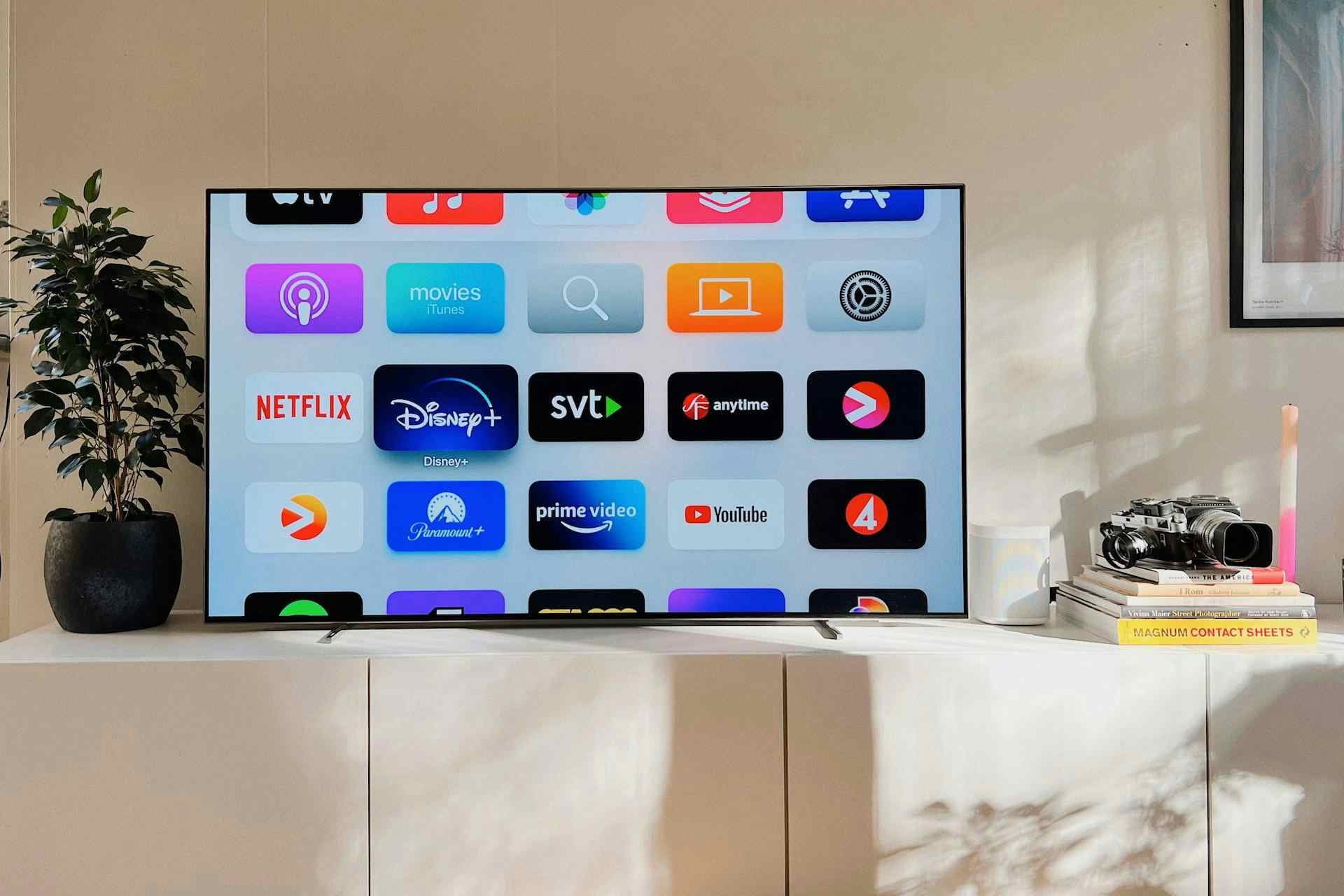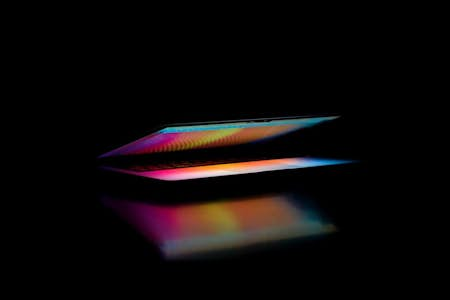TVs have evolved rapidly over the last few decades. While innovation shows little sign of abating, today’s screen technologies are rock-solid and will likely be with us for a long time.
One of those technologies is OLED, or Organic Light Emitting Diode. In contrast to LED TVs, which feature a backlight behind an LCD panel, OLED TVs ditch the backlight and LCD panel for a single layer of sophisticated diodes, each of which produces its own colour and light.
That means infinite contrast ratios and true blacks, as the pixels in an OLED TV can be individually controlled and switched off completely.
OLED technology has been around since 2012, when LG released the first commercially available OLED TV. LG remains the leading manufacturer of OLED TVs today.
Let's learn more about OLED televisions and why you should choose an LG OLED TV.
What is OLED?
OLED display technology uses organic compounds to emit light when an electric current is applied.
Unlike traditional LED/LCD TVs that rely on a separate backlight to illuminate the pixels, each pixel in an OLED panel emits colour and light.
Light is generated in the individual pixels, which are individually powered. That means each pixel can be switched off, producing true blacks.
LED TVs aren't self-emissive, meaning they lack the true infinite blacks of OLED screens. Plus, LED technology is liable to the "halo effect" and bleed, which occurs when light from the backlight unit bleeds through the screen.
The unique characteristic of OLED technology brings numerous advantages, offering a sublime viewing experience that does modern ultra-HD (UHD) TV justice.
5 reasons OLED is the best TV technology
1. Infinite contrast ratio and perfect blacks
One of the most striking things you’ll see when viewing an OLED TV is how deep the blacks are.
Producing deep blacks has always been an issue with screen technology, but OLEDs solve the problem, as each pixel can be switched off totally.
This enables OLED to achieve perfect blacks and an infinite contrast ratio that is impossible with other TV technologies that rely on backlighting.
Infinite contrast ratios result in incredibly lifelike and vibrant images with stunning depth and detail. Also, deep blacks ensure other colours pop as they should.
2. Wide viewing angles
OLED TVs maintain accurate colours and contrast even when viewed from off-centre angles.
This ensures a consistent and enjoyable viewing experience for everyone in the room, regardless of where they sit.
In contrast, LED/LCD and QLED TVs often suffer from colour and contrast degradation when viewed from wide angles.
3. Fast response time and motion handling
OLED panels have an ultra-fast response time, which means they can refresh the image on the screen much quicker than LED/LCD and QLED TVs.
This translates to smoother, blur-free motion handling during fast-paced action sequences in movies, sports events, and video games.
The superior motion handling capabilities of OLED TVs enhance the overall viewing experience, regardless of whether you’re watching TV or films or playing games.
4. Slim and elegant design
The absence of a separate backlight allows OLED panels to be thinner and lighter than their LED/LCD counterparts.
OLED TVs are sleek and minimalist and easily blend into modern living spaces. Their slim form factor means some models can be easily mounted flush against the wall.
5. Rich and accurate colours
OLED technology is renowned for its exceptional colour reproduction capabilities. OLED TVs can display a vast range of colours contrasting against deep blacks for stunning picture quality.
In addition, the self-emissive nature of OLED pixels ensures that colours remain accurate and consistent across the entire screen, providing a true-to-life visual experience.
OLED for different uses
OLED technology is superb for anything and everything we use our TVs for, including TV, movies, and gaming.
Watching TV
OLED TVs provide an exceptional viewing experience for general day-to-day TV watching.
With perfect blacks, infinite contrast ratios, and accurate, vibrant colours, OLED TVs bring out the best in your favourite TV shows.
If you're watching something rich in colour, like a David Attenborough show, expect those colours to look bold and vivid. If it's something fast-paced, like a crime or police drama, OLED TVs are super-sharp and make fast-paced scenes more exciting.
Watching movies
OLED technology truly excels when it comes to watching movies. Its ability to achieve perfect blacks creates a sense of immersive depth and realism – it’s a cut above older TV technology.
Additionally, OLED TVs' support for various HDR formats, such as Dolby Vision, HDR10, and HLG, enhances the luminance, contrast, and colour performance for a more immersive experience.
HDR makes colours and contrasts more realistic and dramatic. Many modern films and TV are produced in HDR, which most OLED TVs support. Top spec HDR provides incredible detail on top-end OLEDs.
Gaming
For gaming, OLED TVs offer a fast response time, typically around 0.1 ms. This translates to smoother, blur-free motion handling during fast-paced action sequences, minimising ghosting and motion artefacts.
Recent models come with advanced features – such as 4K HFR and VRR – as found in the HDMI 2.1 spec, enabling superb performance with ultra-HD gaming consoles and media.
Is OLED considered the gold standard?
OLED is viewed as the gold standard in TV display technology. While newer technologies are in the works, OLED has plateaued screen technology for the foreseeable future – it’s very tough to beat.
While OLED has been around for over a decade, it's been massively refined and has come down in price. This has also made it more reliable and accessible.
However, we need a bit of balance – OLEDs have some downsides. For example, OLED technology is perhaps not the best in ultra-bright rooms. However, newer models perform well in these situations. And watching TV in an ultra-bright and sunny room is far from ideal anyway!
OLED technology and how it compares to other TV technologies
Here, we’ll compare OLED to the other major TV technologies to see how they square up.
OLED
OLED technology uses organic compounds that emit light at the pixel level. Each pixel can be individually controlled in an OLED panel, providing precise colour and brightness adjustments.
Key features:
- Superior contrast ratio: The ability to turn off individual pixels enables perfect blacks and an infinite contrast ratio. This results in exceptional image depth and colour vibrancy. LED/LCD and QLED TVs use backlighting, which can lead to light leakage and lower contrast ratios.
- Wide viewing angles: OLED displays maintain colour accuracy and contrast even at wide angles, providing a consistent viewing experience from any position. LED/LCD and QLED TVs suffer from colour and contrast degradation when viewed from wider angles.
- Fast response time: OLED panels have an extremely fast response time, making them an excellent choice for fast-moving content like sports and video games. Rapid response times minimise motion blur for smooth and clear images. In contrast, LED/LCD and QLED TVs typically have slower response times, resulting in more noticeable motion blur during fast-paced scenes.
- Thinner and lighter design: Due to the absence of a separate backlight, OLED panels can be made thinner and lighter than LED/LCD and QLED panels. This results in sleek, slim TV designs that easily blend into your living space.
LED/LCD (Light Emitting Diodes/Liquid Crystal Display)
LED/LCD TVs remain the most common type of TV available today.
They use a combination of liquid crystals and LED backlighting to create images on the screen.
- Lower contrast ratio: As LED/LCD TVs rely on backlighting, they cannot achieve the perfect blacks and infinite contrast ratio of OLED TVs. This can lead to less vibrant images and poorer black levels.
- Limited viewing angles: The image quality of LED/LCD TVs tends to degrade when viewed from wider angles, with reduced colour accuracy and contrast. This can be an issue in large rooms or when multiple people watch TV from different positions.
- Slower response time: LED/LCD TVs generally have slower response times than OLED TVs, which can result in visible motion blur during fast-moving scenes. Slow response times aren’t ideal for sports or video games.
QLED (Quantum Dot Light Emitting Diodes)
QLED is a variation of LED/LCD technology developed by Samsung that uses quantum dots to enhance colour and brightness.
Quantum dots are microscopic particles that emit light when excited by an external energy source, such as LED backlighting.
QLED TVs offer some improvements over traditional LED/LCD TVs but still fall short of OLED technology in certain aspects. Samsung still manufactures QLEDs, but some of their newer flagship models are OLED.
- Improved colour and brightness: QLED TVs are known for their vibrant colours and high peak brightness levels, making them suitable for brightly lit rooms. However, they still rely on backlighting, which can result in lower contrast ratios compared to OLED TVs.
- Limited viewing angles: Although QLED TVs generally offer better viewing angles than traditional LED/LCD TVs, they still experience colour and contrast degradation at wider angles compared to OLED TVs.
- Slower response time: QLED TVs, like LED/LCD TVs, have slower response times than OLED TVs. While the motion handling capabilities of QLED TVs have improved over the years, they still tend to exhibit motion blur during fast-moving scenes, which may not be ideal for sports or gaming enthusiasts.
MicroLED
MicroLED is an emerging display technology that uses microscopic LEDs to create individual pixels. These tiny LEDs can emit their own light, similar to OLED technology.
MicroLED is still in its infancy and not yet widely available.
Some are available now, but most cost over £50,000, including a 136-inch LG model priced at $300,000 in the United States!
Plus, there will likely be teething issues – so it's worth holding out, even if you can afford it!
- High contrast ratio: Like OLED, MicroLED TVs can achieve perfect blacks and an infinite contrast ratio, as the screen can turn off individual pixels completely.
- Wide viewing angles: MicroLED displays maintain colour accuracy and contrast at wide viewing angles, much like OLED TVs. This ensures a consistent and enjoyable viewing experience regardless of your position relative to the screen.
- Energy efficiency and longevity: MicroLED TVs will probably be more energy-efficient than other TV technologies due to their smaller, more efficient LEDs.
MicroLED technology may become a more viable alternative to OLED and other TV technologies as it matures.
The evolution of modern TVs over the last decade
TVs have evolved rapidly in the previous ten years or so.
Let's journey through the last ten years of TV development to understand where OLED TVs fit in.
2010s: The rise of the smart TV
One of the most significant developments in TVs has been the widespread adoption of smart TVs.
Smart TVs have internet connectivity to connect to streaming apps, web browsers, and app stores. They’re similar to smartphones, as you can use them to download apps, browse the internet, and even for email and video calls.
Smart TVs are now ubiquitous – read our guide on how to choose a smart TV here.
2012: The emergence of 4K ultra HD TVs
In 2012, manufacturers introduced the first 4K Ultra HD TVs, offering a resolution of 3840 x 2160 pixels, four times the resolution of Full HD (1080p).
Over the years, 4K TVs have become more affordable and widespread, with more content available in 4K resolution so you can take advantage of your TV’s capabilities.
2012: Debut of OLED TVs
In 2012, LG released the world's first OLED TV utilising organic compounds to emit light.
OLED TVs offered significant advantages over LED/LCD TVs, such as perfect blacks, infinite contrast ratios, wide viewing angles, and ultra-fast response times.
Although initially expensive, OLED TVs have become more accessible in recent years, making them the new gold standard in TV design.
2015: Introduction of HDR
High Dynamic Range (HDR) emerged as a significant development in TV technology around 2015. HDR TVs provide a higher contrast ratio, brighter highlights, and more intense colours.
2016: Arrival of Quantum Dot TVs (QLED)
Samsung introduced its QLED TV technology in 2016, utilising quantum dots to enhance the colour and brightness performance of LED/LCD TVs.
QLED TVs offer improved colour accuracy and higher peak brightness than traditional LED/LCD TVs, making them suitable for brightly lit environments. However, they still rely on backlighting.
Samsung continues to plough a lone furrow in QLED development.
2018: HDMI 2.1 and eARC
In 2018, HDMI 2.1 was introduced, including support for 8K resolution, higher frame rates, and variable refresh rates (VRR).
HDMI 2.1 also introduced the Enhanced Audio Return Channel (eARC), enabling enhanced connectivity to audio devices like soundbars.
2020s: 8K TVs and Mini-LED
As we entered the 2020s, the first 8K TVs appeared on the market, offering an even higher resolution (7680 x 4320 pixels) than 4K TVs.
Although 8K content is still scarce, these TVs use advanced upscaling algorithms to improve the quality of lower-resolution content.
Another recent development in TV technology is the introduction of Mini-LED backlighting, which uses smaller LEDs to enable more precise local dimming and improved contrast performance.
This technology is often positioned as a middle ground between traditional LED/LCD and OLED TVs
LG's pioneering role in OLED Technology
LG has played a pivotal role in the development of OLED technology. As a pioneer in the OLED TV market, LG has consistently pushed the boundaries, creating a lasting impact on the screen tech industry.
Let's explore some key innovations LG contributed to in the world of OLED TVs.
The first OLED TV
In 2013, LG unveiled the world's first commercially available OLED TV, the 55-inch 55EA9800.
This curved OLED TV showcased the advantages of OLED technology and cemented LG's position as an innovator and leader in the OLED space.
The first 4K OLED TV
In 2014, LG raised the bar even further by releasing the world's first 4K OLED TV, the 77-inch 77EG9700.
Combining the superior image quality of OLED technology with the increased resolution of 4K, this groundbreaking TV delivered sublime picture quality.
Affordability
Over the years, LG has expanded its OLED TV lineup, offering a wider variety of sizes and models, making OLED technology more accessible to a broader audience.
The C-Range has fast-become some of the most awarded TVs in history and comes in various sizes. They're priced like mid-range OLEDs but perform like top-end TVs from other brands like Panasonic, Samsung, Hisense, Philips and Sony.
Technological advancements and partnerships
LG partnered with Dolby Laboratories, which led to the incorporation of Dolby Vision HDR and Dolby Atmos audio technologies in LG's OLED TVs.
These cutting-edge technologies further enhance the visual and audio experience for TV, films and gaming.
Advanced audio processors ensure superb sound quality using the TV's internal speakers or when connecting to an external soundbar or speaker system.
Sustainability and eco-friendliness
LG has also focused on making OLED technology more environmentally friendly.
LG OLED TVs are designed to be energy-efficient, consuming less power than many LED/LCD and QLED TVs.
Award-winning TVs
LG has won stacks of awards, including many for their OLED TV range. Over the last few years, LG’s main OLED TVs have included the B series, C series and stunning wall-mounted G series.
LG has also further enhanced the offering with OLED evo technology – comprising the intelligent α9 processor – the only one in the market dedicated to OLED panel tech – and sophisticated light boosting algorithms. This can be found in newer C and G series models, and provides even brighter and sharper image quality. The 2023 G3 model also has new Light Control Architecture, helping it to go up to 70% brighter than conventional OLED – as massive step forward in OLED technology.
The C1 and C2 are probably the most popular models and have won many awards across major review sites. The C3 is relatively new.
The LG OLED 8K Z3 is the high-end model of LG’s range, weighing in at some £15,000 in 2023 for a 77-inch screen size.
Here’s a non-exhaustive list of LG’s awards:
- In 2021, the LG C1 won the CNET's Editor's Choice Award. The LG CX also won in 2020.
- In WhatHiFi’s 2023 TV review, LG took the top spot for virtually every category, including Best Overall, Best Cheap, Best 8K, Best 42-inch, Best 65-Inch and Best 77-Inch.
- In 2023, TechRadar named the LG C2 range the "best TVs for most people". It also won its TV of the Year award.
- In 2019, LG won over 140 industry awards for their products.
- The LG C2 won the best OLED TV for T33’s 2022 Awards.
So why buy an LG OLED TV?
Choosing an LG OLED TV offers several advantages that elevate your home entertainment experience.
- Superior image quality: LG OLED TVs deliver exceptional picture quality with perfect blacks, infinite contrast ratios, and vibrant, accurate colours, providing an unparalleled viewing experience.
- Wide viewing angles: OLED panels maintain consistent image quality from virtually any angle, making LG OLED TVs ideal for large rooms.
- HDR support: LG OLED TVs support multiple HDR formats such as Dolby Vision, HDR10, and HLG, enhancing image quality and ensuring the best picture across different sources.
- Gaming features: Fast response times, low input lag, advanced HDMI 2.1 spec features like 4K HFR and VRR, and compatibility with NVIDIA G-Sync and AMD FreeSync make LG OLED TVs perfect for gaming.
- Smart TV platform: LG's webOS platform offers a user-friendly interface, a wide range of streaming apps, and voice control through built-in Amazon Alexa and LG’s own ThinQ.
- Sleek design: LG OLED TVs boast a slim, modern design that complements any living space and can seamlessly blend with your home decor.
- Commitment to Innovation: With a decade of experience in OLED technology, LG continually refines and improves its products to deliver exceptional performance and reliability.
LG OLED TVs
OLED TVs have set a new modern benchmark.
If you're yet to experience the potential of OLED, prepare to be wowed by the incredible blacks, stunning colours and astonishing picture response rate.
While virtually all TV manufacturers build OLED TVs, LG was the pioneer and continues to occupy the top rank across virtually all major review sites.
Of course, the competition is hot, but LG delivers superb OLEDs that deliver top performance and stand the test of time.








